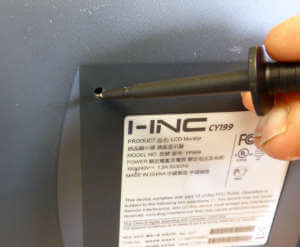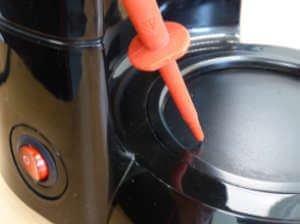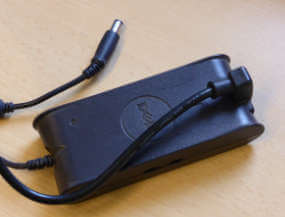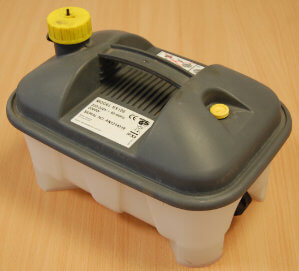Testing Plastic Encased Class I Equipment

Class I appliances may have a case made from plastic with no obvious exposed metal to take an earth continuity measurement.
In most cases this is simply a mater of experience and learning the best place to attach the test lead. For example, an earth connection can usually be found on flat screen monitors and TVs by using a probe on the threads on one of the four mounting holes on the back.

An test probe is also useful for items like this coffee percolator. The earthed metal hotplate is covered by a thin non-stick coating. A sharp probe can be used to pierce through the coating to take an earth continuity measurement.

Class I Power supplies used for IT equipment like monitors and laptops, are earthed for screening the electronics, not for electrical safety. Protection from electric shock is provided by double or reinforced insulation.
It may be possible to get a continuity reading from the dc plug on the end of the charger, however because the earth conductor is not designed to carry a fault current, it is likely to give misleading readings. Therefore this type of equipment should be treated as Class II. If it has a detachable lead set, the lead should be tested separately using a standard Class I lead test.

The IEEE (Institute of Electrical and Electronics Engineers) have recognised the problem identifying functional earth power supplies and introduced a new symbol especially for this type of equipment in 2011. The symbol is a combination of the familiar double insulated, square within a square symbol, and the existing symbol for a functional earth. The new symbol is now on the IEC/ISO database of approved graphical symbols for use on electrical equipment. IEC 62368-1 has also been modified to include the use of the new symbol. IEC 62368-1 is the latest international safety standard for audiovisual products and information technology equipment. It is expected that this standard will eventually replace IEC 60950-1 (safety of ITE). So hopefully this symbol will start to be used on laptop chargers and similar equipment sometime in the near future.
Update - In November 2020 the 5th edition of the Code of Practice was published. The new 5th edition has introduced a new classification for this type of equipment, Class II FE (Functional Earth). We also have an article on the 5th edition update

Some Class I items simply do not have any accessible earthed metal. The example shown here is a wallpaper steamer. It contains a heating element with an earthed metal outer jacket, the same as a kettle. However in this case, it is not possible to access the heating element to attach a probe or clip. The case is all plastic with no other metal parts. The only option is to omit the earth continuity test and just carry out an insulation and earth leakage test. It’s worth pointing out that although an earth continuity test is not required, a Class II leakage test should not be used. A Class II leakage test will measure touch current referenced from the test lead, rather than the protective conductor current. A note should be made on the test records indicating that the earth continuity test could not be carried out.
The Code of Practice requires an earth continuity test on all exposed metal parts. The key word here is ‘exposed’. An exposed metal part, is a metal part that a user could come in contact with. In this case, the metal heating element within the wallpaper steamer is not exposed to the user.
"A continuity test should be made to all exposed-conductive-parts. This may require multiple continuity tests on a single appliance." IET Code of Practice
The IET Code of Practice defines an exposed-conductive-part as:
"A conductive part of equipment that can be touched and which is not normally live, but that may become live under fault conditions." IET Code of Practice